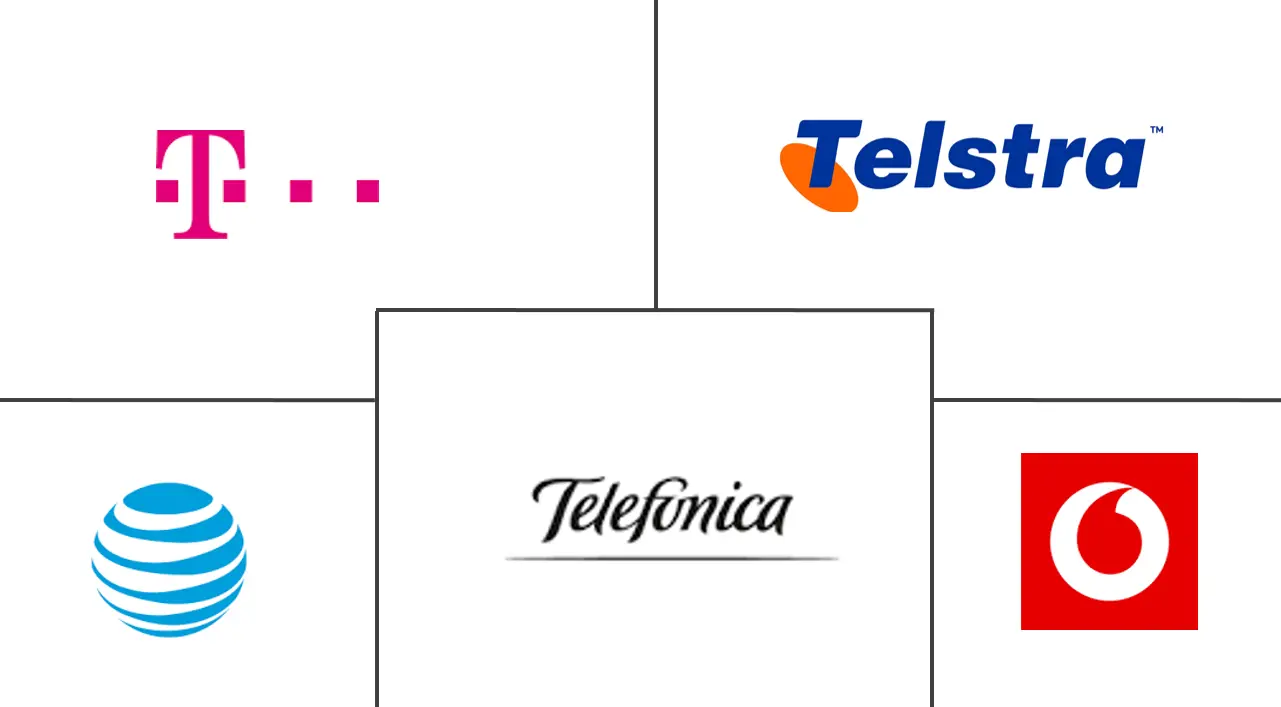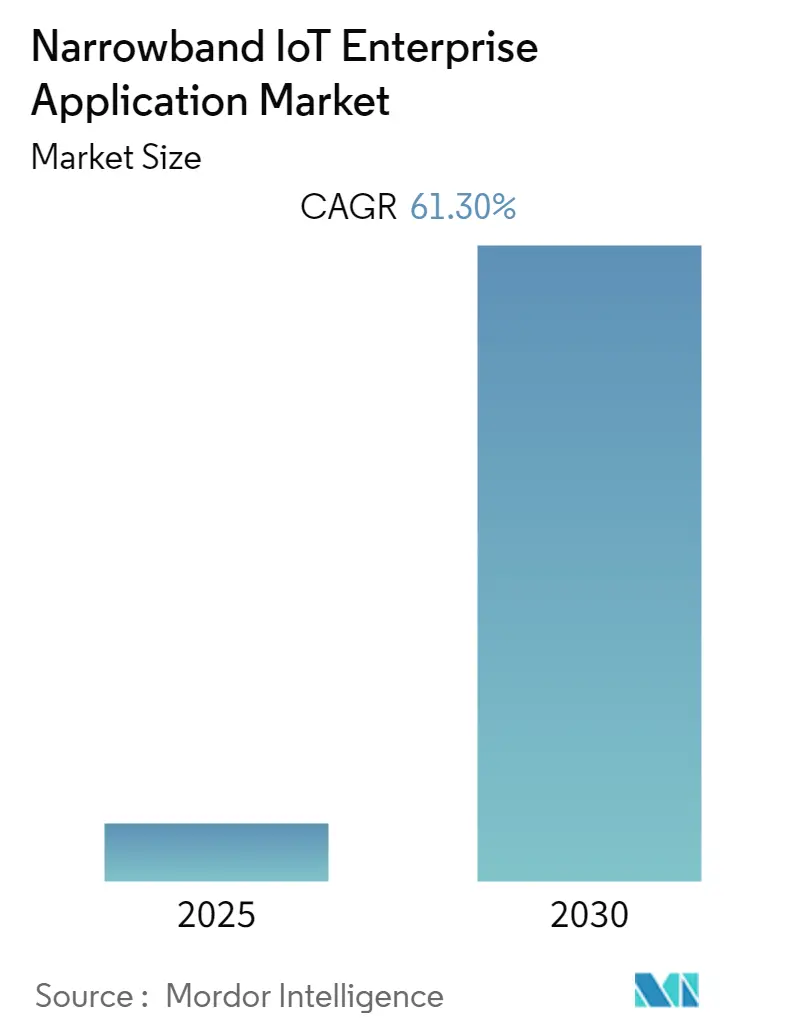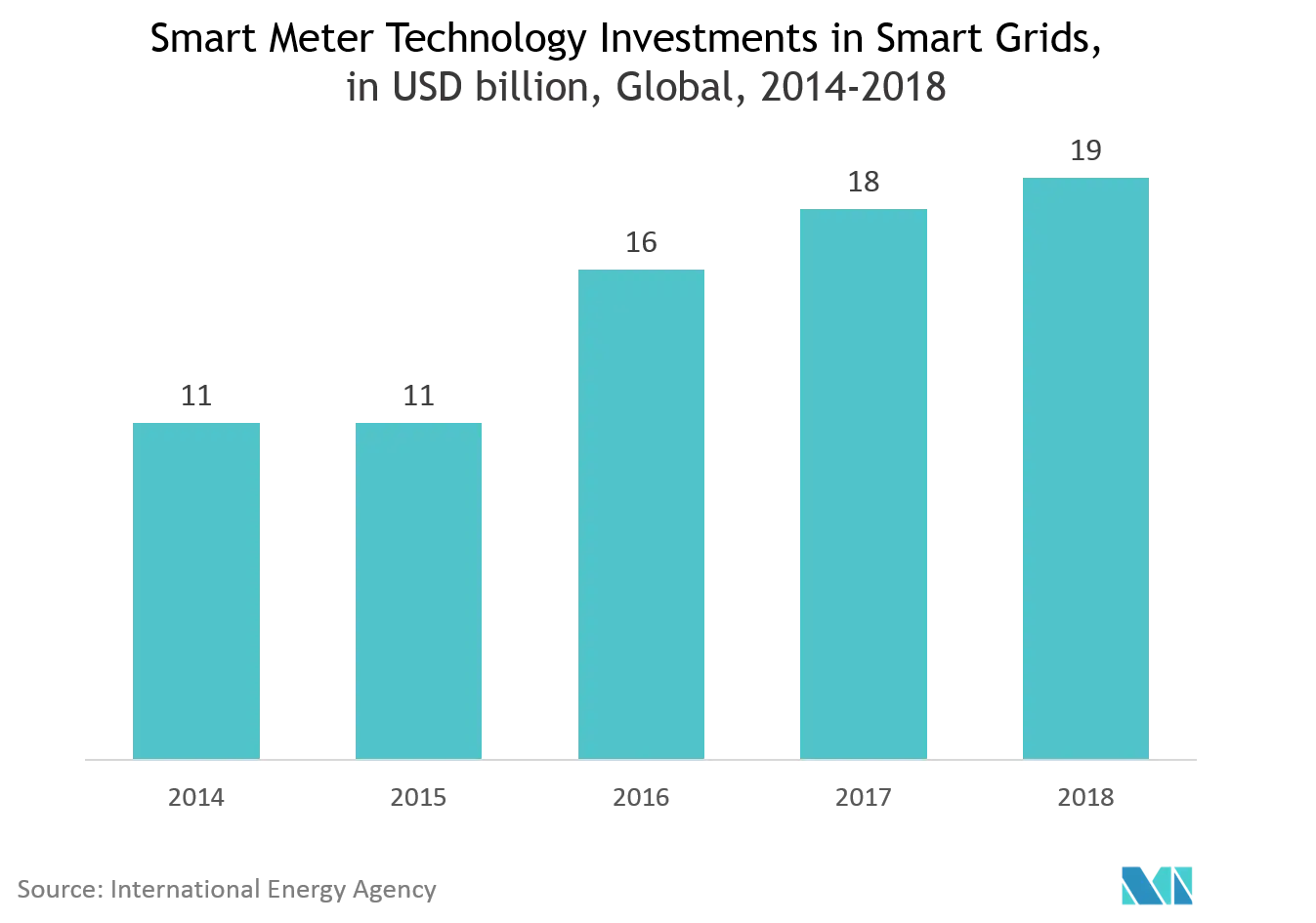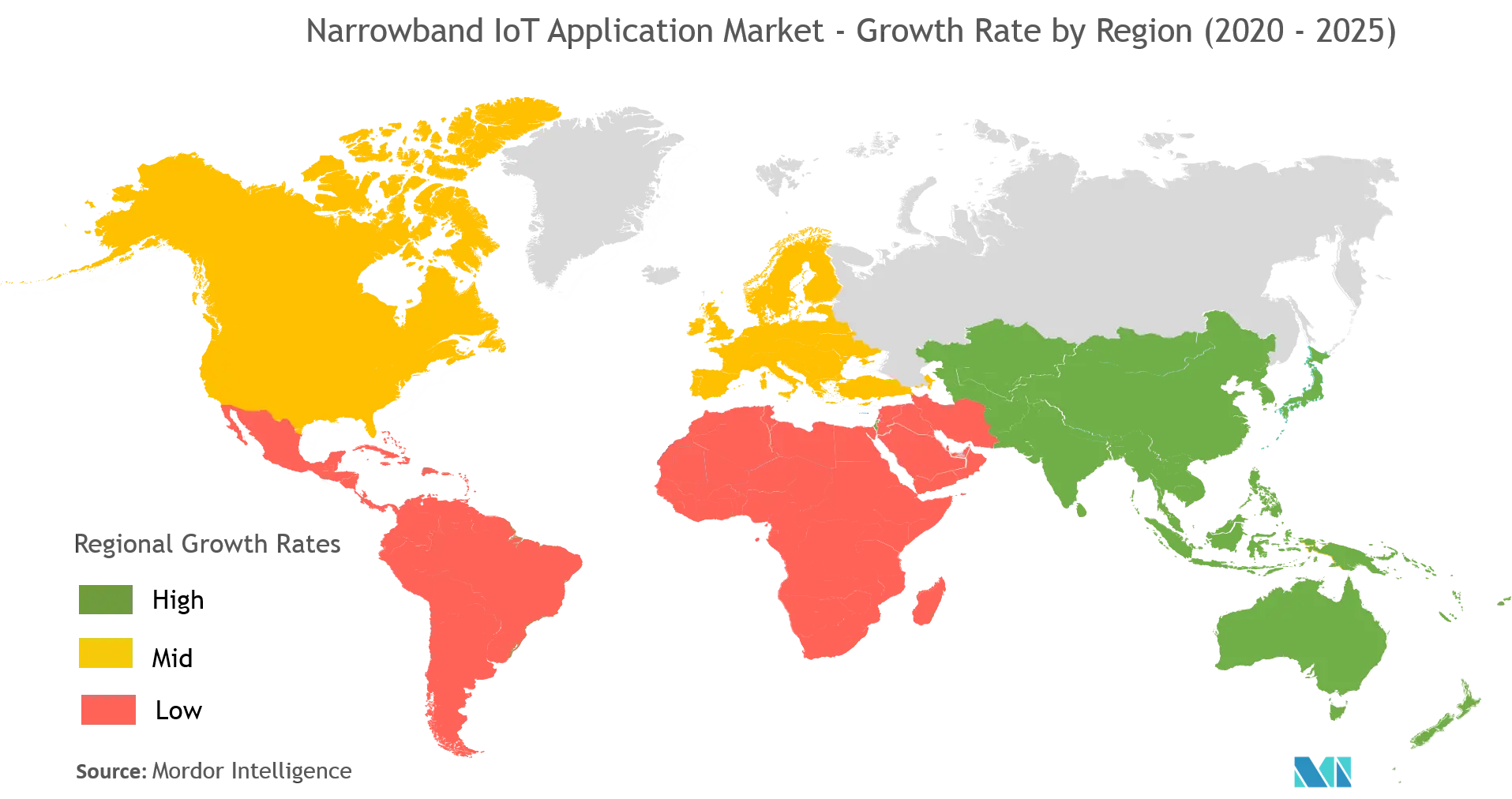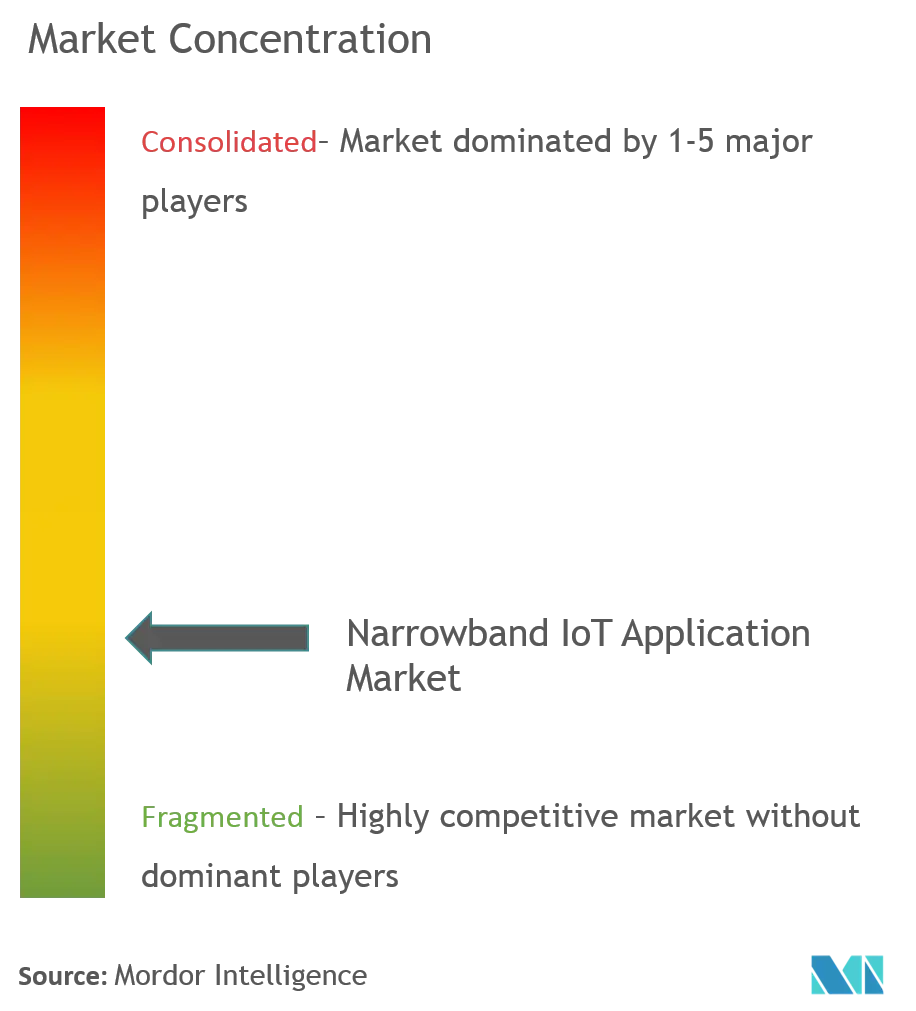Narrowband IoT Enterprise Application Market Analysis
The Narrowband IoT Enterprise Application Market is expected to register a CAGR of 61.3% during the forecast period.
- There is a growing demand for LPWAN across various verticals, along with high deployment flexibility with WCDMA, GSM, or LTE, low deployment cost, and extended coverage and long battery life. These are some of the factors responsible for driving the NB-IoT application market.
- The narrowband IoT also offers better performance in terms of network coverage, reliability and uplink, and downlink traffic as compared to other LPWA technologies such as Lora, SigFox, e-MTC. Vendors claimed that nb-IoT provides 20+dB coverages, 200 kHz bandwidth and 1000x connections, unlike the competition. This instance of NB IoT opens up a plethora of business opportunities for various end-users.
- NB-IoT is mostly used in applications having projects where non-cellular standards are often found. Examples include smart agriculture, smart city applications such as smart parking, smart street lighting, waste management), smart home applications, smart meters, manufacturing automation, smart grid applications, IIoT applications with many low-power devices. It also finds use across Industry 4.0 with condition monitoring and predictive maintenance, environmental monitoring, trackers and more.
- The factors hindering the market growth include transformation downtime of IT systems and competition from rival LPWAN technologies.
Narrowband IoT Enterprise Application Market Trends
Smart Metering Expected to Witness Significant Growth
- Smart metering is expected to witness significant growth for the NB-IoT application market. It is sub-segmented into smart water, smart gas, and smart electric. Smart meters are important elements for utility monitoring and billing and one of the main components of the smart cities. They ensure the most accurate energy bills. Smart metering is further expected to see NB-IoT being integrated into a broader set of products in the coming years, including home appliances, door locks, and smoke detectors.
- Deployment of smart metering systems provides solutions to curb energy wastage in the industry. Implementation of smart metering systems enables energy suppliers to continuously monitor electricity usage by employing smart meter systems at multiple points in the grid.
- The smart metering entity maintains and operates the smart meter data repository that processes, stores, and protects electricity consumption data used for consumer billing by Ontario's local distribution companies.
- In July 2019, a contract was signed between Smart meters company Landis+Gyr and German electric utility E.ON, to install one million smart electricity meters with NB-IoT communication technology, as well as a head-end system on the Gridstream Connect platform. The upgrade will allow end-consumers to improve the efficiency of energy usage.
- According to Pietro Fiorentini, approximately 8 million smart gas meters are installed in Italy, and 0.5 million commercial and industrial gas meter installations are all smart gas meters. About 22 million residential gas meters are expected to be converted to smart gas meters by 2021, as estimated by the company, with the aid of NB IoT infrastructure.
- Moreover, Shenzhen Gas, a prominent energy company, has partnered with China Telecom, Huawei and Goldcard Smart, to test the feasibility of NB-IoT gas meters to solve some of the challenges that the industry faces with the current smart gas meters.
- Government mandates in developed and developing countries, such as Iran, are expected to remain as the primary driver for the smart gas meter deployments. For instance, in Iran, the National Iranian Gas Company has launched a ‘smart gas meter’ project, which makes use of NB-IoT technology for installing 5,000 smart gas meters in the shrine city of Mashhad. Without nation-wide mandates, gas utilities are expected to introduce smart gas meters only for commercial and industrial customers with annual consumption of more than 1,500,000 kWh.
North America Expected to Hold Significant Market Share
- North America is expected to hold a major market share for the NB-IoT application market owing to the early adoption of technologies such as IoT. Businesses in the US are investing billions into LTE network, smart cities projects such as Smart City Accelerator Program, also the presence of major players such as AT&T is able to generate significant revenue share from the region, which further aids to the growth of the market.
- Telecom operators initially deployed LTE-M networks in the region. In April 2019, AT&T, an American multinational telecom company, announced the launch of NarrowBand Internet of Things (NB-IoT) in the US. According to the company, the new network will be able to unlock the next wave of IoT connection, which will further showcase its major step towards 5G and massive IoT. Additionally, businesses also have more choices as the company offers both LTE-M and NB-IoT networks in the US and Mexico by ensuring carrier-grade security.
- Furthermore, In 2019, other players, like Orange, AT & T, and Swisscom, collaborated to launch their LTE-M roaming across their respective IoT networks. The objective of this collaboration is to enable IoT low power devices to operate on multiple networks across North America efficiently. This is suggestive of a step toward global standard development, which will lead to lowered costs and wider deployment in the region, thereby constituting the growth of the market in the region.
Narrowband IoT Enterprise Application Industry Overview
The major companies include Huawei Technologies Co., Ltd, Telefonica S.A., AT&T, Telstra Corporation, among others. The market is highly competitive due to the presence of many major players who are competing among themselves and are also investing huge amounts in R&D for developing better, reliable smart products. Therefore, the market concentration will be low.
- April 2020 - Deutsche Telekom signed its first NB-IoT roaming agreements with partners, including Vodafone, Swisscom, and Telia Company, which will be followed by a complete EU roaming footprint before the end of the year.
- June 2019 - Huawei Technologies Co., Ltd partnered with Nowi Energy B.V in order to leverage its flagship NB-IoT device Soc with the Nowi' energy harvesting PMIC which will further drive new IoT applications requiring an ultra-low-power autonomous operation. The company will also deploy its Boudica V150 development board with integrated V150 NB-IoT SoC and battery charging circuity based on NOWI's NW-A2.3 PMIC Energy Harvesting device in order to counter the power bottleneck in many IoT applications.
Narrowband IoT Enterprise Application Market Leaders
-
Vodafone Group PLC
-
AT&T Inc.
-
Telstra Corporation Limited
-
Telefonica S.A.
-
Deutsche Telekom AG
- *Disclaimer: Major Players sorted in no particular order
Narrowband IoT Enterprise Application Industry Segmentation
NB-IoT is a standards-based low power wide area (LPWA) technology that is developed to enable a wide range of new IoT devices and services. It significantly improves the system capacity, power consumption of user devices, and spectrum efficiency, especially in deep coverage. The technology also provides wide coverage; many connections; low data rates, costs, and power consumption; and optimized architecture. It perfectly satisfies the need for IoT deployment in numerous industries as well as applications.
| By Enterprise Size | Small and Medium Enterprises |
| Large Enterprises | |
| By Application | Smart Metering |
| Smart Asset Tracking | |
| Smart Governance | |
| Facility Management Services | |
| Other Applications (Security, Connected Industrial Assets) | |
| By End-user Industry | Energy & Utilities |
| Retail | |
| Industrial Manufacturing | |
| Transportation & Logistics | |
| Other End-user Industries | |
| Geography | North America |
| Europe | |
| Asia-Pacific | |
| Latin America | |
| Middle East & Africa |
Narrowband IoT Enterprise Application Market Research FAQs
What is the current Narrowband IoT Enterprise Application Market size?
The Narrowband IoT Enterprise Application Market is projected to register a CAGR of 61.3% during the forecast period (2025-2030)
Who are the key players in Narrowband IoT Enterprise Application Market?
Vodafone Group PLC, AT&T Inc., Telstra Corporation Limited, Telefonica S.A. and Deutsche Telekom AG are the major companies operating in the Narrowband IoT Enterprise Application Market.
Which is the fastest growing region in Narrowband IoT Enterprise Application Market?
Asia Pacific is estimated to grow at the highest CAGR over the forecast period (2025-2030).
Which region has the biggest share in Narrowband IoT Enterprise Application Market?
In 2025, the North America accounts for the largest market share in Narrowband IoT Enterprise Application Market.
What years does this Narrowband IoT Enterprise Application Market cover?
The report covers the Narrowband IoT Enterprise Application Market historical market size for years: 2019, 2020, 2021, 2022, 2023 and 2024. The report also forecasts the Narrowband IoT Enterprise Application Market size for years: 2025, 2026, 2027, 2028, 2029 and 2030.
Our Best Selling Reports
Narrowband IoT Enterprise Application Industry Report
Statistics for the 2025 Narrowband IoT Enterprise Application market share, size and revenue growth rate, created by Mordor Intelligence™ Industry Reports. Narrowband IoT Enterprise Application analysis includes a market forecast outlook for 2025 to 2030 and historical overview. Get a sample of this industry analysis as a free report PDF download.

